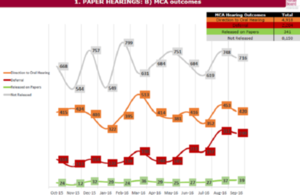Parole Board Quarterly Performance Report
Statistics and performance information for quarter two of 2016/2017 (July - September).

The Parole Board is committed to keeping stakeholders informed of our work and progress towards achieving our objectives. As part of this openness we will publish our quarterly performance report which is produced for the Board’s Management Committee. This report represents a summary of Parole Board operational performance in all its key areas of external delivery and internal management. It provides a snapshot of that period which is used to advise and guide on performance and executive decision making.
The data in this pack shows the large volume of business being processed by the Board, and how that business feeds into hearing demand and outcomes. The number of cases outstanding is now falling on a consistent trajectory and it is hoped the Board will make further significant progress during the rest of the year as we aim to increase the number of hearings held to 750-800 a month.
Based on the year so far, the Board can be confident that by the end of this year we will yet again have completed more oral hearings than ever before and, as the backlog clears, will safely release more people. The deferral rate of hearings remains a concern despite falling over the last few years, as it remains at a high level. We are considering what further steps can be taken to tackle these problems by sharing the reasons for deferrals with the Public Protection Casework team within NOMS (National Offender Management Service) and the National Probation Service.
The below information is intended to aid understanding of the attached performance report, which covers quarter two of 2016/2017 (July - September):
-
Paper Hearings - MCA assessments This graph shows the outcomes from all paper based hearings on a 12 month rolling basis. All cases, irrespective of sentence type or review category are assessed on the papers in the first instance through the Member Case Assessment (MCA) process.
There are a number of outcomes possible at the MCA stage, depending on the sentence type: no release, direct to oral hearing, release, defer. -
Listing Queue for oral hearings This graph shows the queue of cases deemed ready to be considered at oral hearing and currently waiting to be allocated a confirmed date. The graph additionally records those cases that have been waiting more than 90 days for a confirmed oral hearing date, including a figure specifically for IPP cases. This highlights the capacity constraints across the system to list all those cases that are ready to be heard.
-
Oral Hearings Outcomes and Release Rate This graph shows the outcomes from all oral hearings on a 12 month rolling basis. In addition it shows the conduction rate (cases that do actually progress to on the day against the original number of cases listed) and completion rate, i.e. those cases that are concluded on the day. The release rate is also captured in the smaller chart.
-
Deferrals These graphs show the number of cases which are deferred on the day for each month in a 12 month rolling period and also by quarter since 2013. Identifying and mitigating against deferrals is a key aim to contribute to reducing the backlog.
-
Generic Parole Process - Cases Outstanding This graph shows the volume of Generic Parole Process cases that are outstanding in a 12 month rolling period (it does not include recall cases) Case outstanding is defined as all cases referred to the Parole Board for a GPP review, where the original target date to conclude the review has now passed but the review is still ongoing, and as such overdue. A case may be outstanding for a variety of reasons including complexity of the case, case readiness, justified and reasonable deferral or because of an inability of the Board to list the case.
This is a key metric for the Parole Board and reducing this number down to pre-Osborn figures of around 1200 by the end of 2017 is a core focus of our strategy.
If you have any questions relating to this report please contact our Performance Team on info@paroleboard.gsi.gov.uk